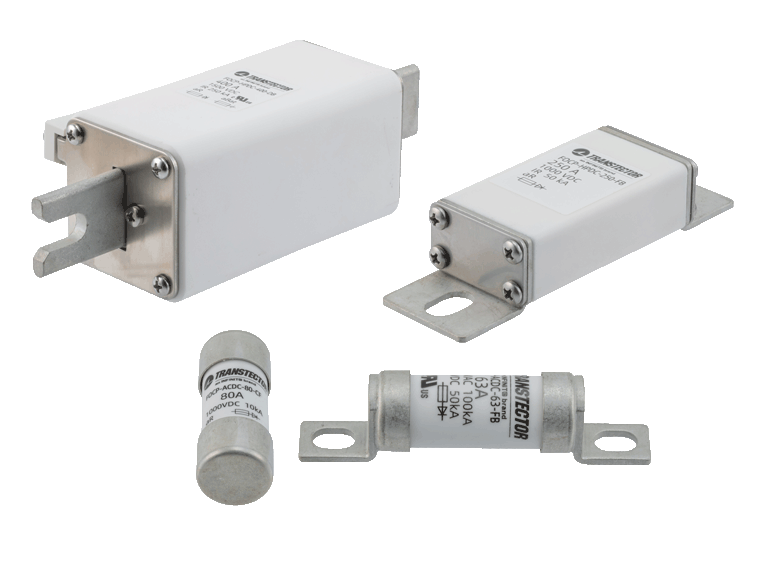Electrical overcurrents can wreak havoc on the power systems of commercial, industrial, and residential structures. Such power inrushes can damage wiring and other infrastructure, present fire and explosion hazards, and even endanger the lives of employees or residents. An essential safety measure is to have dependable AC/DC power fuses that respond instantly when electrical faults occur.
Below we examine how overcurrents can damage power systems, and some basic measures for preventing such damage. We also cover how AC/DC power fuses work to protect facilities and equipment. We conclude with some brief information about Transtector’s new line of AC/DC power fuses.
How AC/DC Fuses Protect Commercial and Residential Power Distribution
- Damage Risk: Overcurrents can damage wiring and sensitive appliances and can overload distribution panels. Overloaded circuits can lead to overheating of wires and components, causing fires.
- Prevention: Circuit breakers and fuses installed in distribution panels are strategically placed to disconnect overloaded circuits. Ground fault circuit interrupters (GFCIs) protect against ground faults, preventing electric shock.
 How AC/DC Fuses Protect Electric Vehicle (EV) Charging Stations
How AC/DC Fuses Protect Electric Vehicle (EV) Charging Stations
- Damage Risk: Overcurrents can harm charging station equipment and EV components. The most common risks include overheating, melting of conductors, damage to electronic components, and even fire. Such overcurrents can be caused by power surges, short circuits, or issues with the electric grid.
- Prevention: Installing fuses and circuit breakers in the charging system helps protect against overcurrents. These devices automatically interrupt the flow of electricity when a predetermined threshold is exceeded, preventing damage to the equipment. You can use overcurrent protection devices specifically designed for EV charging equipment. These devices are calibrated to the specific needs of EV chargers and can protect against various types of overcurrents.
How AC/DC Fuses Protect Solar/Photovoltaic (PV) Power Systems
- Damage Risk: Overcurrents in PV arrays can occur due to factors like shading, soiling, or manufacturing defects in solar panels, leading to a decrease in energy production and potential hot spots. Excessive current can also damage inverters and associated electronics. Inverters are necessary for converting DC to AC power.
- Prevention: Fuses and overcurrent protection devices safeguard solar installations by disconnecting faulty sections. Regular inspection and maintenance of the PV array are also crucial, as are installing bypass diodes in solar panels to mitigate shading effects, and keeping panels clean to avoid soiling.
How AC/DC Power Fuses Protect Power Conversion Equipment
- Damage Risk: Electrical overcurrents can pose a threat to power converters, and the damage they cause can range from component degradation to complete failure of the converter. Overcurrents can occur due to faults, short circuits, or power surges, leading to an excessive flow of current through the power converter.
- Prevention: Fuses, circuit breakers, surge protectors, thermal protection mechanisms, and power quality filters and conditioners can be deployed to interrupt or divert excess current. Also, regular inspections and maintenance can be conducted to find undetected issues and prevent wear and tear over time.
How AC/DC Power Fuses Protect Energy Storage
- Damage Risk: Electrical overcurrents can pose a big risk to energy storage devices, such as batteries and capacitors, leading to various forms of damage. There is a risk of thermal runaway in batteries, leading to fires or explosions. Also, excessive heat generation within energy storage devices leads to thermal stress and degradation of internal components.
- Prevention: Power fuses with appropriate current ratings can be installed to disconnect the energy storage device from the circuit in the event of overcurrent conditions. This prevents prolonged exposure to high currents and mitigates the risk of overheating. To prevent damage to the internal components of the cells, fuses with precise current ratings can be employed to disconnect the energy storage devices from the circuit during an overcurrent.
How AC/DC Power Fuses Protect High-Current DC Power Systems
- Damage Risk: Overcurrents can pose a threat to direct current (DC) power systems, leading to various forms of damage. These include overheating of components such as cables and conductors, transformers, rectifiers, and inverters. Overcurrents can lead to arcing, posing a fire hazard, and to battery damage from heating, electrolyte degradation, and reduced battery life.
- Prevention: Fuses with specific current ratings are used to interrupt the circuit if the current exceeds safe levels. Fuses can prevent damage to DC power components and extend their operational life.
AC/DC Power Fuses: Similarities and Differences
AC and DC power fuses work in similar ways to protect power systems by interrupting the flow of current when it exceeds safe levels. However, there are some differences in their design and operation.
- Melting Element: AC power fuses typically consist of a fusible element made of a material that melts at a specific temperature when exposed to excessive current. DC power fuses do as well, but there are some differences. In AC fuses, the current passes through zero volts every cycle, allowing the arc to extinguish naturally. DC, however, maintains a continuous arc since the current doesn’t naturally go to zero. To handle this, DC fuses often use materials that quench the arc more effectively and quickly than AC fuses.
- Arcing Time: The design of AC fuses takes into account the periodic zero-crossing points of AC waveforms. Since AC current naturally passes through zero during each cycle, AC fuses are designed to allow for a brief arcing time without sustaining the arc. This is essential to avoid re-ignition during the next zero-crossing. DC power systems lack the zero-crossing points present in AC systems, leading to continuous arcing if a fault occurs. DC fuses need to interrupt the current more quickly to prevent sustained arcing.
- ‘Blow and Clear’ Principle: When the current exceeds an AC or DC fuse’s rated capacity, the fusible element heats up and melts, creating an air gap. The arcing caused by the melting is extinguished at the next zero-crossing, and the circuit is interrupted. This process is known as the “blow and clear” principle.
- Rapid Interruption: AC fuses are designed for rapid interruption to minimize the energy let-through during the arcing period, providing effective protection for AC systems.
- Arc Chute or Quenching Device: DC power fuses often incorporate additional features, such as an arc chute or a quenching device, to help extinguish the arc more effectively in DC systems. These devices are essential for dealing with the continuous nature of DC arcs.
- Voltage Polarity Consideration: DC fuses are designed with consideration for the polarity of the voltage across the fuse, as interruptions under DC conditions can be affected by the direction of the current flow.
Transtector’s New AC/DC Power Fuses
Transtector recently introduced a line of AC/DC power fuses. Our diverse new offerings come in various form factors and mounting configurations and cover a wide range of service levels, from 10 to 630 amps. Stop overcurrent damage before it happens with our new line of dependable AC/DC fuses.
Key Features:
- Popular Mounts – We offer fuses with DIN-bolt mounts, fuses with flat-bolt mounts, and fuses with cartridge-type mounts.
- High-Speed – Instant response to protect wiring, infrastructure, and personnel
- Certified Dependable – Select models are UL certified
- Replaceable – Easy to replace
- Diverse Service Levels – Including a 10-amp AC fuse, a 63-amp AC/DC fuse, an 80-amp DC fuse, a 100-amp AC/DC fuse, a 125-amp DC fuse, a 200-amp DC fuse, a 250-amp DC fuse, a 350-amp DC fuse, a 400-amp DC fuse, and a 630-amp DC fuse.
Transtector’s new AC/DC power fuses are in stock and available for same-day shipment.For more info, visit Transtector.com or contact us at +1 (208) 635-6400.




